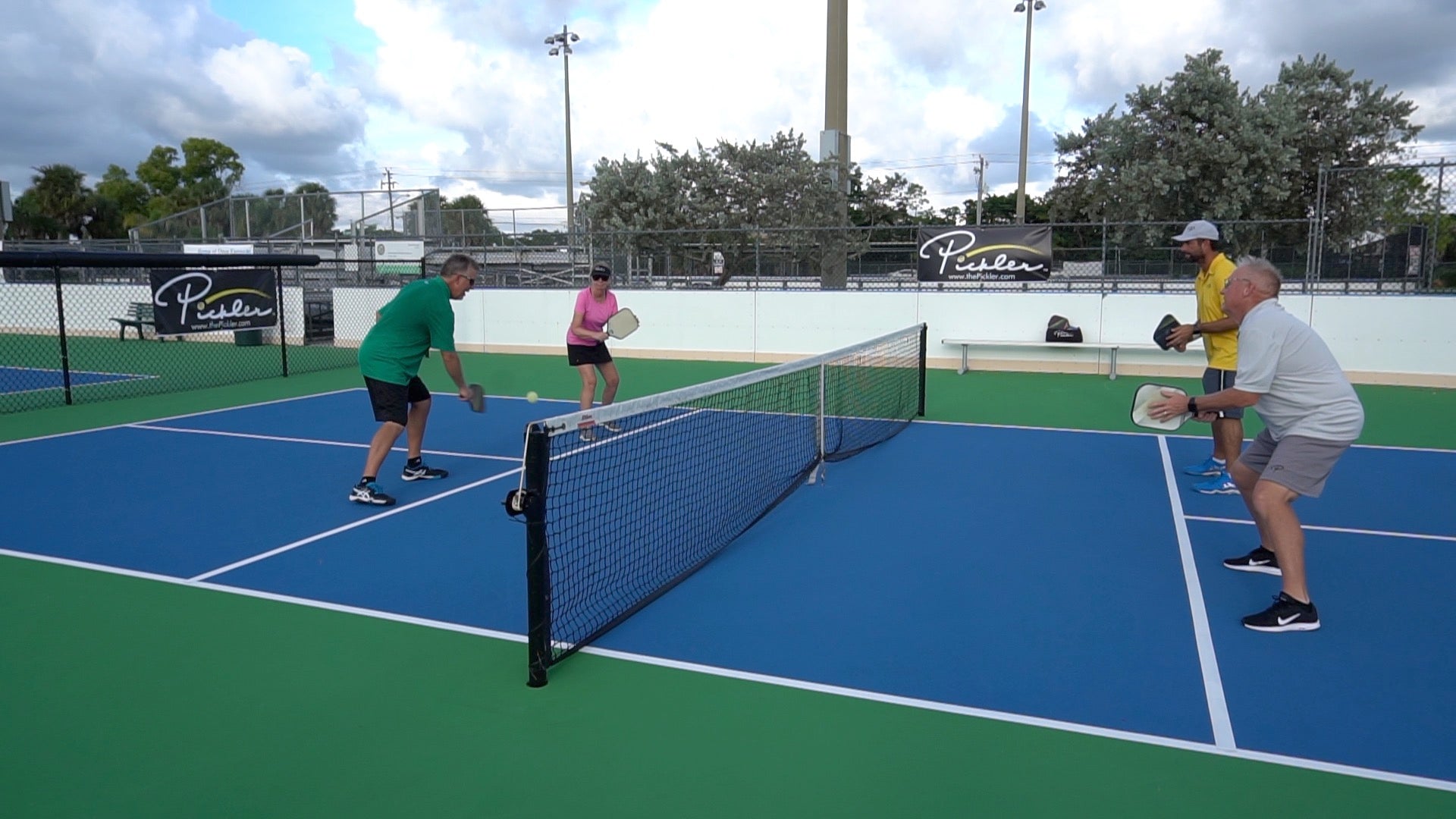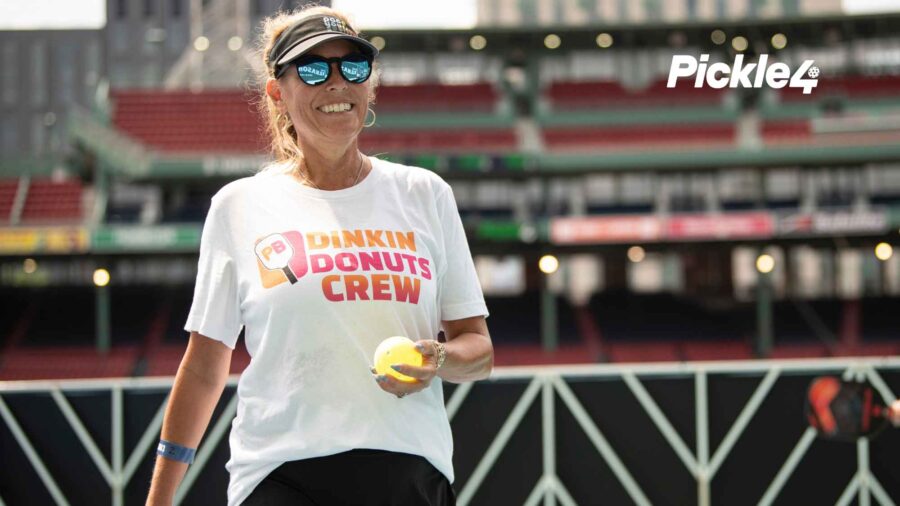USAPA Pickleball University
Back in January, 2019, my wife and I had the pleasure of attending the East Coast USAPA University at Club Med in Sandpiper Bay, Florida, where we delved into an intensive exploration of pickleball techniques and strategies. This was my first experience learning from seasoned pros, and it was incredibly rewarding. The pros were, by the way, the following:
- Sarah Ansboury was a 5.5 tennis player and a USPTA and NCAA coach at Pacific University when she discovered pickleball in 2014. One year later, she earned Gold and Silver at the Tournament of Champions, medaled four times at the USAPA National Tournament, and won 5 medals at the US OPEN Pickleball Championship.
- Rob Davidson is recognized as one of the top players and instructors in pickleball. He is a full-time instructor and is one of the first instructors certified by the IPTPA.
- Tim Kuss is the Pickleball Teaching Professional at Pinehurst Country Club and an original founding member of SSIPA (Super Senior International Pickleball Association).
- Brian Staub, resident of The Villages, Florida, is a top pickleball pro and coach, who commonly plays on the senior pro circuit. Brian has won countless medals, including gold medals at the USA Pickleball National Championships, Tournament of Champions and the US Open Pickleball Championships.
- Jennifer Lucore is a professional pickleball player, a global ambassador, and a 2019 Inductee into the Pickleball Hall of Fame, and USA Pickleball historian. Her numerous GOLD medal championships include 17-time USA Pickleball Nationals, 11-time Canadian Nationals, 6-time Huntsman World Senior Games, 6-time International Tournaments, 4-time Tournament of Champions, and many golds at the US Open Pickleball Championships and pro tours.
- Byron Freso is the Head Referee of the Association of Pickleball Professionals—APP Tour and leads SportsEdTV’s Ask Our Ref feature which answers pickleball questions from our community.
It would be hard to put together a more experience and more accomplished set of instructors.
Primarily focusing on dinking, serving, and volleying, the camp offered a plethora of enlightening drills and engaging games that significantly enriched our understanding and proficiency in this dynamic sport. Below, I encapsulate our experiences and newfound insights from this educational camp.
Two-Person Dink Games: Elevating Precision and Control
The camp commenced with a series of two-person dink games, meticulously designed to refine our precision and control over the ball. In the first game, akin to a crosscourt warm-up with a competitive twist, players engaged in cross-court dinking until a participant faltered by hitting the ball long or into the net. The introduction of a center line, whether real or imaginary, augmented the challenge and strategic approach to the game, fostering heightened concentration and accuracy.

TWO-PERSON DINK GAME 1
The camp commenced with a series of two-person dink games, meticulously designed to refine our precision and control over the ball. In the first game, akin to a crosscourt warm-up with a competitive twist, players engaged in cross-court dinking until a participant faltered by hitting the ball long or into the net. The introduction of a center line, whether real or imaginary, augmented the challenge and strategic approach to the game, fostering heightened concentration and accuracy. This is a game most of us are familiar with.
TWO-PERSON DINK GAME 2
Expanding on this foundation, subsequent games introduced nuances to the dinking dynamics. In the second iteration, players were granted the opportunity to execute slams into the non-volley zone (NVZ), accompanied by a caveat—failure to get the ball into the NVZ on your opponent’s half-court resulted in point forfeiture. This modification not only tested our ability to seize opportunities but also emphasized tactical awareness and placement precision. “Firefights” were prohibited.
TWO-PERSON DINK GAME 3
In the third game variant, players were permitted to integrate lobs into their repertoire, further diversifying strategic options. Remarkably, the recipient of the lob was required to execute a third-shot drop—a testament to the multifaceted nature of pickleball strategies. Despite initial skepticism regarding the feasibility of such maneuvers, the efficacy of the third-shot drop was underscored through practical application, highlighting its viability even among seasoned players.
FOUR PLAYER GAMES
The four-player games are the same as the two-player games with a few additions. One is that you don’t have to dink cross-court – you can dink to the person in front of you. This reinforces what one of the pros called a “reset.” If you get a dink from your opponent that forces you to move toward the outside line, you can use a reset to avoid a more difficult cross-court dink.

The other change is that, after four successful dinks, you can play the point out as you would in a regular game. This makes you aware that a bad dink, one that is too high, for example, will let you opponents hit winners. It also makes you aware that you have to be ready to hit winners yourself.
TWO PERSON “SKINNY SINGLES”
I played this game on the morning of the last day. The picture below shows how the game works.

If you have an even score (including zero), you stand in the deuce court. Same for your opponent. So, the diagram above shows the lineup when you both have an even score. In this case you would be playing cross-court.
If you have an odd score, then you stand in the ad court. Assume that you are serving 2-1. Since your opponent has an odd score, he or she will be in the Ad Court. This is that lineup.

You can play wither a dink game in which you must keep the ball in the NVZ, or a full-on game. The ball, however, must go to your opponent’s court and vice versa. I personally liked the dink game, but the full-on game is very good for working on the location of your serve. (I have since changed the way I play skinny singles)
ZONE DINK DRILLS
We also learned two dink drills – this means that you are not having a contest, but working with your partner to make sure the drill keeps going.
The court layout for these two drills is shown in the picture below.
Note that the NVZ is divided into six zones. In the first drill you will dink to each zone in numerical order. Your drill partner will tell you if your dink was good or not, but even if it is not, you continue playing.
In the second drill you place your dink as follows: zone 1, 3, 5, 4, 2 and 6. This is a really tough drill! Not only is it confusing, but you have to change direction a few times.

One thing I learned – and I should have known this – is that the closer you get your dink to drop by the net, the better it is. That’s why this drill is so great – you really have to focus on zones 4, 5 and 6.
PADDLE CONTROL GAMES
We played a number of interesting games that focused on paddle control. In one game, you dinked to your partner who more or less caught the ball on his or her paddle, bounced it on the paddle once and dinked it back. This game helps in two ways – you control the paddle and you control the dink to make sure your partner can get it back. This is not a scoring game unless you want to determine who messed up your rhythm.
A second game we played was called “paddle volleyball.” In this game you played against another team. You can have three or four players on a side. The way it works is this: your opponents dink the ball to your side. One player gets the dink and then passes it to one of his teammates. That player then passes it to another team mate. You have to pass it three times before you can dink it back to your opponents.
The ball must bounce when you pass it and no player can pass the ball to himself. You can hit it twice as long as another player hits the ball before you hit it the second time. It is a very fun game.

CRAZY GAME
I don’t know what else to call this game. The picture below shows how you set up.
You can stack as many players as you like behind the first two players.
So, imagine that player 1 dinks the ball over. He or she has to get off the court as fast as possible because player 3 has to move up and take that position. Player 1 goes to the back of the stack of players.
If player 2 gets the return, he or she has to get off the court, the that player gets off the court and player 4 moves up.
It is a very fast game and can have hilarious results. I cannot tell you how many times players tried to get off the court by moving to the middle, thereby creating a collision. Also, there were many times when the player moving up from the stack shoved his or her teammate out of the way.

You start the game off by dinking. After that, you can play out the point any way you like except for lobbing. You can imagine what situation that would create.
You’d think that driving down the middle would be a winning strategy, but remember that a player is moving up from the middle so that didn’t work so well. The winning strategy was to either slam it to the open spot or dink it back, with dinking being the best strategy.
SUMMARY
The great thing about some of these drills/games is that you only need two people. If you have four, so much the better for working on an actual game situation.
In retrospect, the USAPA Pickleball University proved to be a transformative experience, not only refining our technical skills but also fostering a deeper appreciation for the strategic intricacies and collaborative dynamics inherent to the sport. Unfortunately, USAPA does not seem to be interested in hosting a camp at this level again, and that is disappointing. I hope the organization has a change of heart, but perhaps there is too much competition from others at this point in time.




